What's Important in a Beginner RC Plane?
Following on from the beginner rc airplanes page, here we'll continue to look at what's important in a trainer plane.
First and foremost, the basic design is very important; when learning to fly an rc airplane you need a plane with stable and forgiving flight characteristics. As previously explained, a high wing plane of conventional design will always have inherent stability.
This stability is greatly helped by dihedral, which is the upward angle of each wing from its root to tip. Dihedral isn't unique to high wing planes though, you'll see it on the majority of planes, jets and gliders.
Power: Internal Combustion or Electric?
An rc plane's power type is an important thing to consider and these days most beginner rc airplanes are electric powered (EP) as opposed to internal combustion (IC).
EP, at beginner level at least, means convenience and lower costs - always good news for a newcomer to any hobby!
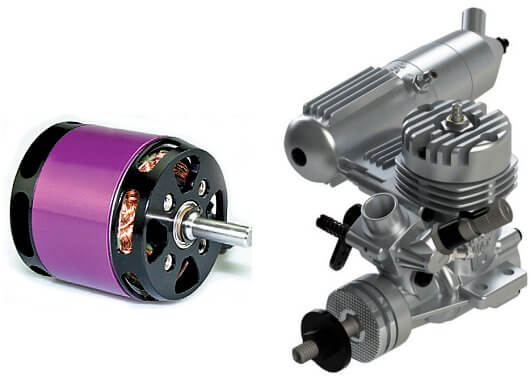
Above: a modern brushless electric motor and glow plug engine.
It's fair to say that the majority of new rc pilots do start with electric, but there are IC powered trainers available. Such planes aren't as straightforward and convenient as electric ones, due to the presence of the engine.
Club membership and proper instruction should be seriously considered with an IC model plane, unless you have good access to private land and know someone who already flies IC and is willing and able to teach you.
This is simply because IC powered planes aren't as 'public friendly' as electric ones, and flying one in a public area such as a park isn't such a good idea.
My advice is to go electric, especially if you intend to self-teach.
Construction Level
RTF
Most beginner rc planes are sold Ready To Fly, or RTF. This means that there is no building work for you to do, other than perhaps some basic final assembly.
Any final assembly really comes down to how big the plane is; smaller planes often come completely assembled, whereas larger ones will likely need the tailplane and wing attaching to the fuselage.
Pictured below is your typical RTF as purchased, in this case the Super Cub LP from HobbyZone® (©RCM&E, with permission).
Learn more about RTF rc planes.
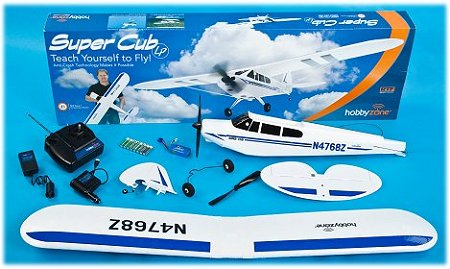
ARF / ARTF
If you think you'd like a go at learning some basic aeromodeling skills, then perhaps an Almost Ready To Fly rc airplane will suit you.
ARF's (or ARTF, depending on where you are in the world) come about 90% assembled and you have to finish them off. This will include sourcing and installing the power unit and radio gear. You'll also need to fit hardware and set up the plane yourself (or with help from a fellow modeler, of course!).
ARF rc planes are very common these days, making up a large percentage of planes found on a typical flying field. The quality of them has improved hugely, and they are very widely available.
Learn more about ARF rc planes.
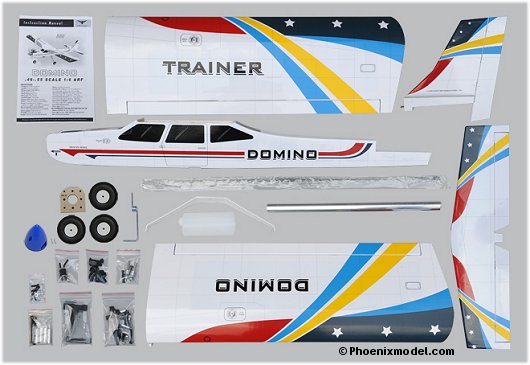
Above: an ARF rc trainer plane, out the box. A few evenings work should see it complete!
Build from a Kit / Plan
The third option is to build your model from a kit, or from scratch. Truthfully, there aren't that many beginner airplane balsa kits out there, since manufacturers recognise the fact that most new rc pilots just want to learn to fly, not learn to build as well!
That said, there are some beginner kits around. Certainly here in the UK, a company called Vintage Model Company is doing a great thing by developing easy-to-construct balsa beginner rc planes. Their Super Cub and Spitfire kits seem to be selling well and introducing newcomers to the excitement and satisfaction of true aeromodeling!
Learn more about balsa plane kits.
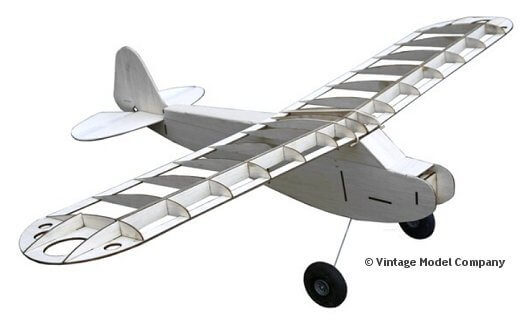
Above: the Vintage Model Company Balsa Basics Super Cub kit.
So those are your main options as far as construction levels are concerned.
The bottom line is if you just want to get flying in the least amount of time, with the least amount of fuss and expense, then an electric Ready To Fly rc airplane is the way to go.
RC Airplane Construction Material
Definitely a major thing to think about is which material the plane is made from.
Traditionally rc planes are from balsa wood with plywood used where additional strength is needed. But over the last couple of decades or so, foam rc airplanes have dominated the trainer plane market. In fact, foam planes nowadays can be bought for any experience level - there are some amazingly detailed scale aircraft for the advanced modeler available in foam.
From the beginner's point of view, a foam trainer is the way to go. Foam rc planes are cheaper to manufacture so can be sold at lower prices, and foam is a relatively easy material to repair. Yes, it's sometimes 'frowned upon' by the older generation of traditional aeromodelers, but the fact is that foam rc planes are here to stay, and they're just getting better and better.
Think about Spare Parts!
This isn't something you might consider when choosing your first beginner rc plane, but spare parts availability is most definitely something to bear in mind.
I would be lying if I said that, whilst you are learning to fly your radio control plane, you'll never crash it. Even after you've learned, you're still likely to crash it sooner or later!
The truth is, radio control planes do crash now and again and, unsurprisingly, the likelihood of crashing as you are learning to fly is very high. Unfortunately it's just a part of the hobby, and you need to accept that fact!
It makes sense, then, that buying a beginner rc plane that carries a good choice of spare parts is sensible. All the major manufacturers should be able to supply spare wings, tail surfaces, airframes etc. at a reasonable cost, and you must be happy to accept that you will be buying such a part at some time!
This is perhaps another reason why buying an RTF plane is probably the best choice for the beginner - repairs are, generally speaking, easy to make and spare parts easy to fit.
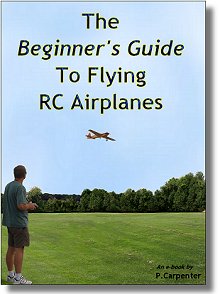 New to the hobby? Avoid those nasty beginner mistakes that could hurt your pride and your wallet, with The Beginner's Guide to Flying RC Airplanes. 135 pages of essential info, including a full rc flight school section, my ebook will get you started safely and quickly.
New to the hobby? Avoid those nasty beginner mistakes that could hurt your pride and your wallet, with The Beginner's Guide to Flying RC Airplanes. 135 pages of essential info, including a full rc flight school section, my ebook will get you started safely and quickly.
It's very reasonably priced and you'll get the ebook via instant download. It's a tiny price to pay for learning how not to crash your plane on its maiden flight!
Regardless of power type, construction level and material, choosing a radio control airplane that is designed for beginners will mean a massive difference to your initial enjoyment of the hobby.
Trying to learn with a more advanced rc plane will almost certainly end in disaster, putting you off this exhilarating pastime for life.
Maybe your first rc plane won't look exactly how you'd like it to but learning to fly safely is the prime factor here. Once you've got a few hours under your belt you can then move on to bigger and better things.
All the above Flight School topics are covered in more detail in my Beginner's Guide To Flying RC Airplanes ebook.
